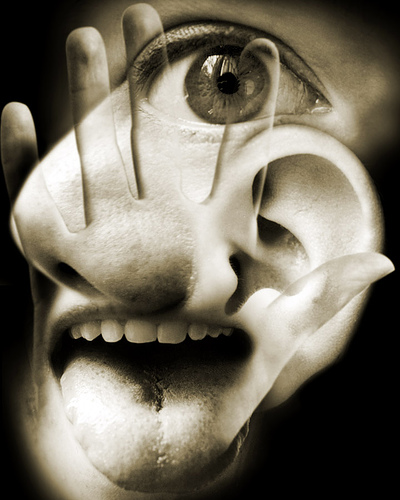
1. Seeing or vision describes the ability to detect light and interpret it as
"sight". There is disagreement as to whether or not this constitutes one,
two or even three distinct senses. Neuroanatomists generally regard it as
two senses, given that different receptors are responsible for the
perception of colour (the frequency of light) and brightness (the energy of
light). Some argue that the perception of depth also constitutes a sense,
but it is generally regarded that this is really a cognitive (that is,
post-sensory) function derived from having stereoscopic vision (two eyes)
and is not a sensory perception as such.
2. Hearing or audition is the sense of sound perception and results from tiny
hair fibres in the inner ear detecting the motion of atmospheric particles
within (at best) a range of 20 to 20000 Hz. Sound can also be detected as
vibration by tactition. Lower and higher frequencies than can be heard are
detected this way only.
3. Taste or gustation is one of the two "chemical" senses. It is well-known
that there are at least four types of taste "bud" (receptor) and hence, as
should now be expected, there are anatomists who argue that these in fact
constitute four or more different senses, given that each receptor conveys
information to a slightly different region of the brain. The four well-known
receptors detect sweet, salt, sour, and bitter, although
the receptors for sweet and bitter have not been conclusively identified. A
fifth receptor, for a sensation called "umami", was first theorised in 1908
and its existence confirmed in 2000. The umami receptor detects
the amino acid glutamate, a flavor commonly found in meat, and in artificial
flavourings such as monosodium glutamate.
4. Smell or olfaction is the other "chemical" sense. Olfactory neurons differ
from most other neurons in that they die and regenerate on a regular basis.
The remaining senses can be considered types of physical feeling.
5. Tactition is the sense of pressure perception.
6. Thermoception is the sense of heat and the absence of heat (cold). It is
also the first of the group of senses not identified explicitly by
Aristotle. Again there is some disagreement about how many senses this
actually represents--the thermoceptors in the skin are quite different from
the homeostatic thermoceptors which provide feedback on internal body
temperature. How warm or cold something feels does not only depend on
temperature, but also on specific heat capacity and heat conductance; e.g.,
warm metal feels warmer than warm wood, and cold metal feels colder than
cold wood, because metal has a higher thermal conductivity than wood. Wind
feels cold because of the heat withdrawn for evaporation of sweat or other
moisture, and because an isolating layer of warm air around the body blows
away; however, in the case of hot air, wind makes it feel hotter, for a
similar reason as the latter.
7. Nociception is the perception of pain. It can be classified as from one to
three senses, depending on the classification method. The three types of
pain receptors are cutaneous (skin), somatic (joints and bones) and visceral
(body organs).
8. Equilibrioception is the perception of balance and is related to cavities
containing fluid in the inner ear. There is some disagreement as to whether
or not this also includes the sense of "direction" or orientation. However,
as with depth perception earlier, it is generally regarded that "direction"
is a post-sensory cognitive awareness.
9. Proprioception is the perception of body awareness and is a sense that
people rely on enormously, yet are frequently not aware of. More easily
demonstrated than explained, proprioception is the "unconscious" awareness
of where the various regions of the body are located at any one time. (This
can be demonstrated by anyone closing their eyes and waving their hand
around. Assuming proper proprioceptive function, at no time will the person
lose awareness of where the hand actually is, even though it is not being
detected by any of the other senses).

0 comments:
Post a Comment